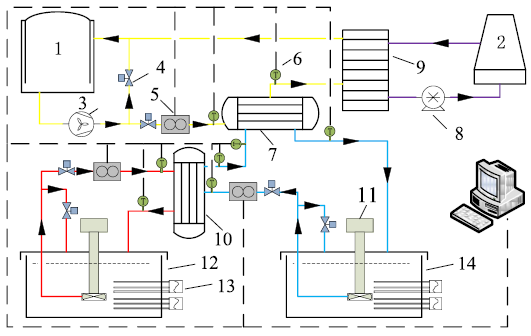Molten salt heat exchangers are key components in some advanced power systems. Two shell-and-tube molten salt heat exchangers are experimentally investigated, including a gas cooled one with finned tubes and a molten salt to salt one with segmental baffles in the shell side. Based on a nonlinear regression scheme, heat transfer coefficients in both the tube and shell sides are obtained. Heat transfer characteristics of molten salt in the tube side are discussed and compared with three empirical correlations. It is found that Wu’s Equation has better agreement with the experimental data than Gnielinski’s and Hausen’s Equations in transitional flow region. For the developing laminar flow in the tube side, the widely used Sieder–Tate correlation underestimates heat transfer coefficients of molten salt by up to 30%. Compared with oil and a chart method proposed from sufficient database, molten salt seems to have better heat transfer performance than other working fluids in the baffled shell side. Further researches on the heat transfer characteristics of molten salt in the shell side with baffles are needed and significant.
(1) Laminar flow in the tube side for molten salt turns to transitional flow at Re = 2500. For the developing laminar flow, the traditional Sieder–Tate correlation underestimates the heat transfer coefficients of molten salt by up to 30%.
(2) For transitional flow in the tube side, the empirical heat transfer correlation for molten salt proposed by Wu is more accurate than the other two widely used empirical correlations: Gnielinski’s Equation and Hausen’s Equation.
(3) In the shell side, flow of molten salt is laminar within Re < 210, transitional when 210≤ Re ≤550 and turbulent when Re > 550. There is a sensible difference between molten salt and oil in the heat transfer in the baffled shell side.
(4) Calculation method based on existing database will underestimate the heat transfer coefficients of molten salt in the baffled shell side by 19%. Molten salt seems to have better heat transfer performance than other working fluids in the baffled shell side. Further researches on the flow and heat transfer in the shell side with baffles are needed for molten salt.

Fig.1. Schematic of the experiment system. 1— gas tank, 2— cooling tower, 3— fan, 4— electric valve, 5— flowmeter, 6— thermocouple, 7— gas cooled heat exchanger, 8—water pump, 9— water cooler, 10— molten salt to salt heat exchanger, 11— salt pump, 12— hot salt tank, 13— electric heaters, 14— cold salt tank.